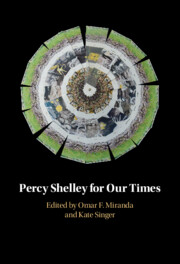Book contents
- Percy Shelley for Our Times
- Reviews
- Percy Shelley for Our Times
- Copyright page
- Contents
- Notes on Contributors
- Acknowledgments
- Abbreviations
- Introduction
- 1 Shelley, Treaty-Making, and Indigenous Poetry
- 2 Waiting for the Revolution
- 3 “A Chamæleonic Race”
- 4 Dream Defenders and the Inside Songs
- 5 Radical Suffering
- 6 Loathsome Sympathy
- 7 Hopeless Romanticism
- 8 Percy Shelley’s Sad Exile
- 9 Shelley in the Overgrowth
- 10 Creatrix Witches, Nonbinary Creatures, and Shelleyan Transmedia
- 11 Action at a Distance
- 12 Educating the Imagination/Defending Shelley Defending
- Further Reading
- Index
6 - Loathsome Sympathy
Shelley’s The Cenci and the Problem of Empathy
Published online by Cambridge University Press: 07 March 2024
- Percy Shelley for Our Times
- Reviews
- Percy Shelley for Our Times
- Copyright page
- Contents
- Notes on Contributors
- Acknowledgments
- Abbreviations
- Introduction
- 1 Shelley, Treaty-Making, and Indigenous Poetry
- 2 Waiting for the Revolution
- 3 “A Chamæleonic Race”
- 4 Dream Defenders and the Inside Songs
- 5 Radical Suffering
- 6 Loathsome Sympathy
- 7 Hopeless Romanticism
- 8 Percy Shelley’s Sad Exile
- 9 Shelley in the Overgrowth
- 10 Creatrix Witches, Nonbinary Creatures, and Shelleyan Transmedia
- 11 Action at a Distance
- 12 Educating the Imagination/Defending Shelley Defending
- Further Reading
- Index
Summary
Critics have long argued over Beatrice Cenci’s guilt and moral responsibility in relation to her murder of her father and rapist, as Shelley himself anticipated they would. Far less attention has been paid, however, to Count Cenci’s program for corrupting his daughter and turning her, at least in part, into a mirror version of himself. Count Cenci engineers a perverse kind of empathic identification, one that Shelley calls, in Prometheus Unbound, “loathsome sympathy.” This chapter presents “loathsome” sympathy in turn as an extreme or inverted form of the sympathy that plays so crucial a role in Shelley’s poetic and ethical theories, theories he develops from passages in various eighteenth-century moral philosophers including Hume, Rousseau, Burke, and Adam Smith. Twenty-first-century research on empathy and “mirror neurons” provides a number of partial and provocative analogies with eighteenth-century sympathy theory that are used heuristically to provide a novel perspective on the tradition that leads from Hume to Shelley. The chapter looks especially at how mirror neuron research emphasizes the embodied, visual, intersubjective, and unconscious workings of empathy. Shelley, the chapter argues, develops a comparable sense of sympathy, one that, in its “perverse” version, informs The Cenci.
- Type
- Chapter
- Information
- Percy Shelley for Our Times , pp. 133 - 155Publisher: Cambridge University PressPrint publication year: 2024

